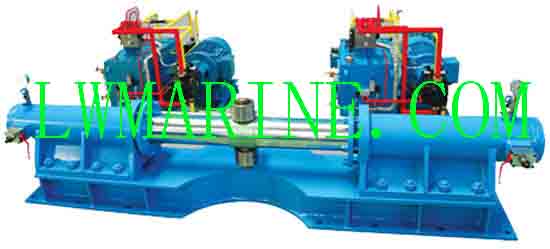Introduction to Marine Steering Gears
Marine steering gears are critical propulsion control systems that convert rotational commands from the ship’s bridge into precise rudder movements. These complex electro-hydraulic or electric systems serve as the vessel’s “nervous system,” determining directional control and maneuverability. Modern steering gears comply with stringent SOLAS regulations requiring redundant systems for fail-safe operation.
Types of Marine Steering Systems
1. Electro-Hydraulic Steering Gears (Most Common)
- Ram-Type Actuators:
- Two or four hydraulic cylinders
- Provide high torque for large vessels
- Standard on tankers and cargo ships
- Rotary Vane Systems:
- Compact design with hydraulic vanes
- Reduced maintenance requirements
- Common on cruise ships and Ro-Ro vessels
2. All-Electric Steering Gears
- Motor-driven screw actuators
- Simplified maintenance
- Emerging technology for eco-ships
- Limited to smaller vessels (<5,000 GT)
3. Mechanical Steering Systems
- Traditional cable/pulley arrangements
- Found on small craft and historical vessels
- Lacks power assistance
Marine Steering Gears Key Components & Terminology
| Component | Function | Criticality |
|---|---|---|
| Rudder Actuator | Converts hydraulic/electric power to mechanical motion | Primary |
| Tiller Arm | Connects actuator to rudder stock | Structural |
| Hydraulic Power Unit (HPU) | Generates hydraulic pressure | Power Source |
| Telemotor System | Transmits bridge commands | Control Link |
| Autopilot Interface | Integrates with navigation systems | Automation |
| Emergency Power | Backup power source | SOLAS Requirement |
Marine Steering Gears Operational Principles
Steering Process Flow:
- Command Input: Wheel movement at bridge
- Signal Transmission: Electronic or hydraulic telemotor
- Power Conversion: HPU pressurizes hydraulic oil
- Actuation: Cylinders/vanes move tiller arm
- Rudder Movement: 35° port to 35° starboard (typical)
- Feedback: Rudder angle indicator verification
Redundancy Systems:
- Two independent power systems
- Automatic switchover during failure
- Emergency manual bypass
- Dual pumps and piping
SOLAS Safety Requirements
- 30-second rudder movement: Hard-over to hard-over
- Two steering systems: Main + auxiliary
- Emergency power: 15 minutes for tankers, 10 for others
- Rudder angle indicators: Bridge and machinery spaces
- Automatic overload protection
Marine Steering Gears Performance Parameters
| Metric | Standard Range | Critical Thresholds |
|---|---|---|
| Response Time | <4 seconds | SOLAS: <28 sec (15°→15°) |
| Rudder Torque | 50-5000 kNm | Vessel size dependent |
| Operating Pressure | 150-220 bar | Alarm at ±10% deviation |
| Oil Temperature | 40-60°C | Shutdown at >70°C |
Marine Steering Gears Maintenance Best Practices
Daily Checks:
- Hydraulic oil levels
- Unusual noises/vibrations
- Leak inspection
- Rudder response test
Monthly Maintenance:
- Hydraulic Filtration: Replace elements
- Oil Analysis: Check water content
- Ram Inspection: Scoring/pitting checks
- Electrical Connections: Tightness verification
Annual Overhaul:
- Full hydraulic oil replacement
- Seal replacement (rams/vanes)
- Tiller arm alignment check
- Safety system simulation tests
Common Failure Modes & Solutions
- Hydraulic Oil Contamination:
- Symptoms: Erratic movements, pressure fluctuations
- Solution: Triple filtration, oil replacement
- Air Entrapment:
- Symptoms: Spongy operation, noise
- Solution: System bleeding, seal checks
- Electrical Faults:
- Symptoms: Control system failures
- Solution: Motor insulation tests, contactor cleaning
- Mechanical Binding:
- Symptoms: Overload alarms, slow response
- Solution: Rudder stock alignment, bearing lubrication
Emerging Technologies
- Digital Twin Systems: Predictive maintenance
- Direct Drive Electric Actuators: Eliminate hydraulics
- AI-Powered Steering: Optimized course-keeping
- Green Hydraulic Fluids: Biodegradable oils
Industry Certifications
- Class Society Approvals: ABS, DNV, LR, BV
- ISO 19030: Performance monitoring
- IEC 60945: Environmental testing
- MSC.365(93): SOLAS compliance
Conclusion
Marine steering gears represent mission-critical systems where failure can lead to catastrophic consequences. Understanding system architectures, SOLAS requirements, and predictive maintenance directly impacts vessel safety and operational efficiency. As shipping evolves toward autonomous operations, steering systems continue incorporating advanced redundancy protocols and digital monitoring capabilities to ensure fail-safe navigation in all conditions.
Keywords: Marine steering gear, ship rudder system, electro-hydraulic steering, ram-type steering, rotary vane steering, tiller arm, rudder actuator, SOLAS steering requirements, steering gear maintenance, hydraulic power unit, rudder angle indicator, marine propulsion control.
